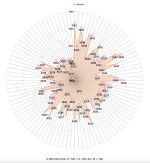...
Newberry’s OCW has been shown to produce accurate repeatable loads. by shooting round robin and looking at loads that have similar POI, it attempts to identify aa load that is insensitive to minor changes primers, charge weight and case vol/prep. It is quantitative in nature. Once a node is found, as you state, it must be verified as stable by additional shooting. It tries to minimize outside factors that effect accuracy in testing such as wind. Unfortunately, the primary source of error in the method is the shooters ability. This is true with any method that relies on a human for operation and a target for analysis.
Showing insensitivity to "minor changes in....." relies on the assumption (unless you have data showing otherwise?) that there is sensitivity in minor changes in those variables.
Here's 20x each of the same load (6mm ARC 110 A-tip w/Varget) with 3 different primer types, all else the same. SD for each test was within 1fps. Avg MV for all 3 was within 6 fps.
Everything I've seen with powder ladders is that if you're changing charge weight less than about .7-1.0 grain increments, you're unlikely to see any meaningful performance difference. All this is why everyone's chosen method seems to show great results-- because it all works.
Obviously there are exceptions, and there are combinations that shoot like poopoo, but so long as you pick a bullet your barrel likes and a powder your barrel likes, you can do whatever confirmation bias funnel load development you want and end up with a great shooting combination.


